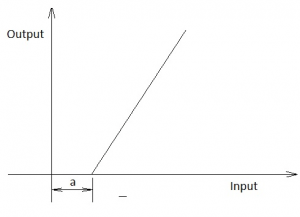This set of Instrumentation Transducers Interview Questions and Answers focuses on “Performance Characteristics of Transducers”.
1. Closeness of measured value to true value is _________________
a) Accuracy
b) Precision
c) Correction
d) Uncertainty
View Answer
Explanation: Accuracy of a measurement is defined by closeness of a measured value to true value.
2. _______________ of a measuring system refers to its ability to follow instant by instant the measurand with time.
a) Bandwidth
b) Fidelity
c) Measurement lag
d) Settling time
View Answer
Explanation: Fidelity of a measuring system or transducer refers to its ability to follow instant by instant the variations of measurand with time.
3. For a measuring system, dynamic sensitivity is required to be ________ of static sensitivity.
a) ±2%
b) ±5%
c) ±10%
d) ±20%
View Answer
Explanation: For a measuring system, tolerated variation of dynamic sensitivity is only ±2% of static sensitivity. That is dynamic sensitivity should be minimum.
4. What is the span of an instrument, operating under a bias which read a value from 230V to 450V only?
a) 450
b) 220
c) 230
d) 400
View Answer
Explanation: Span of an instrument is the difference between upper and lower calibrated values. Hence, span in this case is 450 – 230 = 220.
5. Given input out characteristic of a typical system, name the region marked as ‘a’.

a) Dead zone
b) Range
c) Drift region
d) Threshold
View Answer
Explanation: Dead zone is the region in which output starts responding to input. It is marked as region a, below which there is no output for input.
6. What will be the ratio of amplitudes of largest (maximum) signal to smallest (minimum) signal to which the system is subjected?
a) Time constant
b) Settling period
c) Dynamic range
d) Bandwidth
View Answer
Explanation: Ratio of amplitude of a large signal to small signal is termed as a dynamic range of the system.
7. For a Measurement, indicated value is 225V while true value if 226V. What will be the static error of an instrument?
a) 1V
b) -1V
c) 0.5V
d) -0.5V
View Answer
Explanation: Static error is the difference between a measured value and true value of a measurement. Here measured value is 225V while true value is 226V.
8. What is the relation between static error and static correction?
a) Static error is negative of static correction
b) Both are equal
c) No relation
d) Both will be always positive
View Answer
Explanation: From the definition of static correction and static error, it is clear they both are negative to each other.
Static correction = (true value – indicated value) = – (static error).
9. What is the term used to express the ability of a measuring system to maintain its standard performance?
a) Zero stability
b) Stability
c) Sensitivity
d) Linearity
View Answer
Explanation: Stability of a system is defined as the ability to maintain its standard performance over prolonged time. Transducers and systems with high stability need not be calibrated.
10. What is ‘live zero’?
a) Output zero for zero input
b) Output non zero for zero input
c) Output null for all input
d) Output unpredictable
View Answer
Explanation: Live zero is a term used to describe a system in which output has a nonzero value for zero input.
Sanfoundry Global Education & Learning Series – Instrumentation Transducers.
To practice all areas of Instrumentation Transducers for Interviews, here is complete set of 1000+ Multiple Choice Questions and Answers.
If you find a mistake in question / option / answer, kindly take a screenshot and email to [email protected]
- Check Instrumentation Transducers Books
- Apply for Instrumentation Engineering Internship
- Check Instrumentation Engineering Books
- Practice Instrumentation Engineering MCQs
